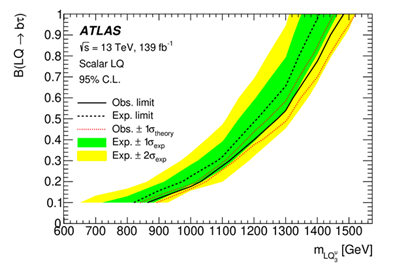New ATLAS search for third-generation Leptoquarks

Leptoquarks (LQs) are well-motivated hypothetical particles that couple to both quarks and leptons, thus providing a link between the two sets of fermions that can explain their similar family structure in the Standard Model. Phenomenologically, they are attractive since they provide a potential explanation for the hints of lepton flavour non-universality seen in flavour experiments and for the g-2 anomaly.

The observed (solid line) and expected (dashed line) 95% CL upper limits on the branching ratio into charged leptons (B) as a function of mLQ for scalar LQs.
The ATLAS Experiment has recently submitted a new publication, led by Liverpool’s Dr Carl Gwilliam, searching for third-generation LQs decaying to a b-quark and a tau-lepton. Although no evidence for LQs was found, upper limits on the production cross-section as a function of LQ mass (mLQ) and their branching ratio into charged leptons (B) were set (see Figure). Assuming B=1, Scalar (spin-0) LQs with mass below 1.49 TeV are excluded, while for vector (spin-1) LQs the corresponding limit is up to 1.96 TeV depending on the model. Using advanced multivariate techniques, these results improve previous ATLAS results in this channel by more than 450 GeV in the scalar case, setting world best results in all models.
Further information: